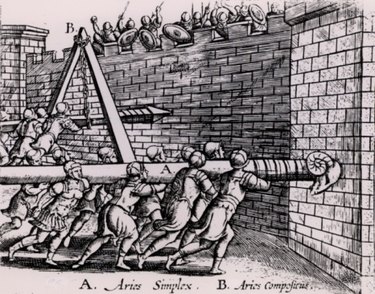Things You'll Need
Reference books
Drawing materials
Foam board
Craft knife
PVA glue
Basing material
Thin card
Drinking straws
Fake fur
Balsa wood
Acrylic paints
Paintbrushes
Flock

Making a model fort for a school project can be educational and fun. Although at first the prospect of making a model can seem daunting, it's easier than it looks. Whether you're carefully recreating a historical building or designing something from your own imagination, you can achieve impressive effects using simple techniques and materials. With a little time and careful planning, you can make a model fort that stands out from the crowd.
Step 1
Decide on the scale you want to use. If you're building a replica of a historical fort, pick a scale that means you can fit your model into a reasonable space. It's a good idea to pick a scale that corresponds to one used by modeling hobbyists, such as 1/72, 1/100 or 1/300. This will allow you to use commercially available model soldiers, trees and other accessories.
Video of the Day
Step 2
Draw a plan of your fort. If you're building a historical fort, find a plan of the fort in a history book or online. Otherwise, study forts of the same period to get an idea of the layout.
Step 3
Draw out the shape of your fort's walls on foam board with a pencil. This is a lightweight, sturdy material consisting of a layer of foam between two sheets of card. It will make a good material for your fort's walls. Draw each section of the walls separately, remembering to leave spaces for them to join up. Mark out holes for doors or windows, where present.
Step 4
Cut out the walls of your fort carefully using a craft knife. Fit the pieces together to see how they work, then glue them into position using PVA glue. You may need to hold the walls together with masking tape while the glue dries.
Step 5
Choose a base for your model. You will want a base that is rigid and lightweight. Medium density fiberboard is one option, as is insulation foam, which you can carve to represent hills and valleys, if necessary.
Step 6
Build internal buildings and place them around the fort. On a typical fort, these might includes barracks, mess halls, armories and stables. For roofing material, use thin card, such as the cardboard from cereal boxes. Tiles can be represented by cutting drinking straws into a half-cylinder shape and teddy bear fur soaked in PVA glue and painted brown makes good thatch.
Step 7
Add other structures to your fort, such as walkways, crenellations, window shutters or doors. You can make doors or shutters from balsa wood or thin card. If building walkways, test them to make sure they can bear the weight of models.
Step 8
Texture your fort's walls. If the walls are likely to be rough, apply a mix of paint and sand to break up their smooth texture. Suggest stonework by cutting out shapes of card and gluing them to the walls. You don't have to cover the whole area; a few patches will give the impression. Lines of stones at the corners will also help cover up joins between segments.
Step 9
Paint your fort. Acrylic paints are best for these materials. Vary the shades of the walls slightly as you paint -- stone or brick buildings aren't simply unrelieved blocks of gray. Use paint mixed with water to create streaks on areas where rain might have stained the walls.
Step 10
Add details. You can get scale trees and figurines at model shops; place figures about the fort to give the impression of activity. Paint the base around the fort with textured paint in a dark earth color. Put a small amount of a lighter earth color on your brush and brush it over the textured paint. This will create a highlight and break up the earth tone. For grass, brush PVA glue onto the base and sprinkle model railroad flock onto it.
Tip
You can give balsa wood a weathered, wood-grain effect by brushing it with a metal brush.
Warning
Use caution when using a craft knife. Always make cuts away from your body.
Video of the Day